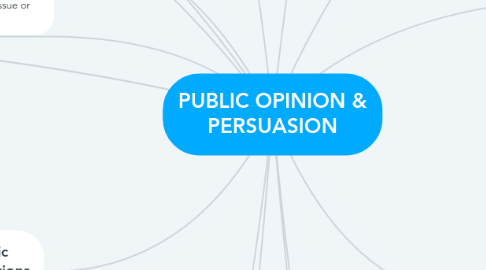PUBLIC OPINION & PERSUASION
by Miza Zahari

1. Public Relations Public
2. Public in PR differ from the “general public”.
3. Public is a group of people internally or externally with whom an organization interacts
4. There are 4 reasons for PR to identify their organizations public: -To determine relevant PR programmes. -To determine priorities and work within the budget and resources provided. -To reduce media cost. -To prepare message that is acceptable and effective.
5. 8 Most Important Publics 1.Employees/The staff (Internal) 2.Local community (External) 3.Prospective staff and potential employee (External) 4.Suppliers and services (External) 5.Distributors (External) 6.Consumers and Users (External) 7.Opinion Leaders (External) 8.The media/ The Press (External)
6. Grunig's Situational Theory of Publics
7. Segmenting a population into publics: - Extent to which communicating an issue passively or actively. - Extent to which they support or constraints the organization’s pursuit of its mission
8. Publics are more likely to be active when: - Organization involves them. (level of involvement) - Organization did something wrong . (problem recognition) -They are not constraint from doing something about the problem. (constraint recognition)
9. Important Elements of Defining Public Opinion (Vincent Lowe)
10. - Should be publicly expressed. - Should be a matter of public interest. Should be held by the general public.
11. Public is any group or possibly individual that has some involvement with an organization.
12. Public are any group of people who are tied together, however loosely, by some common bonds of interest or concern and who have consequences for an organization.
13. The Formation of Public Opinion (Multiple –Step Flow Theory )
14. Opinion leaders will obtain Information from mass media > Opinion leaders share the info with attentive public > Some will become interested or aware too (inattentive public) > the expression of opinion
15. Factors Influencing Public Opinion
16. 1.Familial 2.Religious 3.Educational 4.Social Class 5.Race 6.Personal 7.Cultural
17. Steps In Persuasion Process 1.Presenting 2.Attending 3.Comprehending 4.Yielding 5. Retaining
18. Role of Media in Influencing Opinion Mass media are the most influential in making people aware of an issue or topic.
19. Ethics of Persuasion
20. -Do not use false evidence to support the claim. -Do not use unsupported or illogical reasoning. -Do not use irrelevant appeals to divert attention from the issue at hand. -Do not ask audience to link your ideas to emotion laden values, motives or goals to which is not related.
21. Public Opinion
22. is what most people in a particular area think. It's a collective opinion. (Dough Newson, Allan Scott and Judy VanSlyke,1993)
23. is the complex of preference expressed by significant number of persons on an issue of general importance. (Bernard Hennessy)
24. Public- A group of people who share a common interest in a specific subject. Opinion- The expression of an attitude on a particular issue or subject. Attitude- A predisposition to respond in a given way to an issue or situation (Vincent Lowe , 1986)
25. Categories of Public
26. Categories of Public1) Internal Public Groups of people who are already part of the organization. 2) External Public Groups of people who are not a part of the organization.
27. Potential of Public for Organization 1.Customers 2. Members of the public in general. 3. Trade and community distributors. 4. Financial public. 5. Opinion Leaders. 6. Pressure groups. 7. The media 8. Overseas Government and International. 9. Central and local government bodies. 10. Research bodies and policy forming unit. 11. Local trade unions. 12. Employees.
28. Five Basic Element of Public Opinion ( Bernard Hennessy)
29. 1. Focused on an issue like disagreement. 2. Must consist of a recognizable group of persons concerned with the issue. 3. Complex of preference. 4. Expression of opinion involved printed, spoken words, symbols or even gasp of a crowd. 5. The impact is a measurable effect.
30. Monitoring Public Opinion (Source )
31. 1.Personal Contact 2.Media reports 3.Field reports 4.Letters and telephone calls 5.Advisory committees 6.Staff meetings 7.Polling and sampling
32. Persuasion
33. A process that changes attitudes, beliefs, opinions, or behaviors.It is used to win people over
34. It is used to win people overIt is used to win people over
35. 8 Factors in Persuasive Communication 1. Audience Analysis 2. Source credibility 3. Appeal to self interest 4.Clarity of message 5. Timing and contract 6.Audience Participation 7.Suggestion for action 8. Content and structure of message


